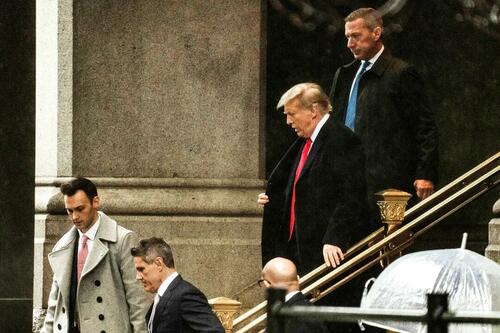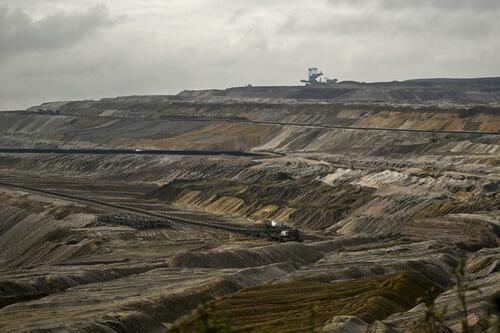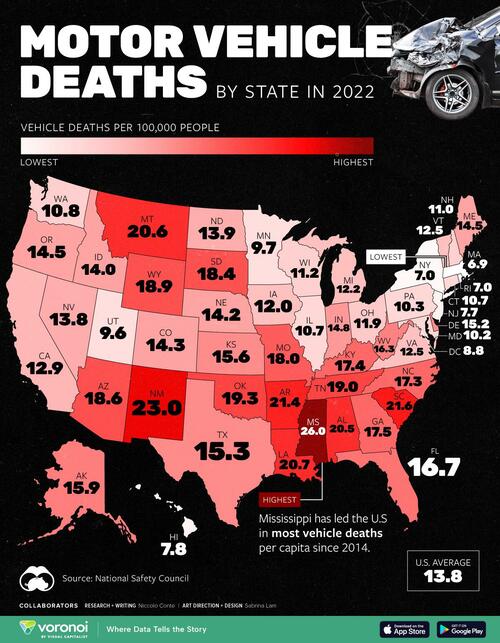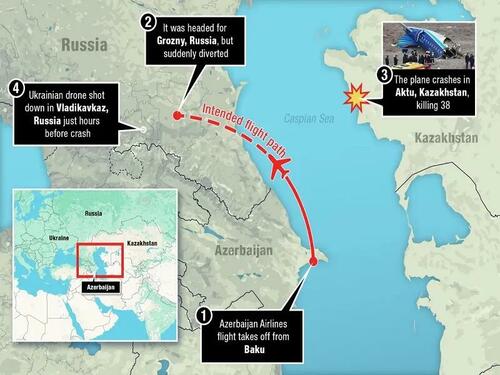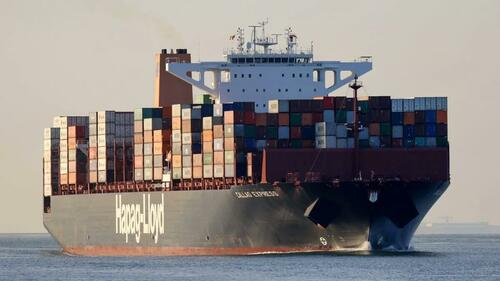Authored by James Howard Kunstler,
Forecast 2025 – Taking Out the Trash
“A core reflex in these decades of postmodern insanity was constant rejection of things we thought we knew in favor of New, Improved Beliefs packaged from above.”
– Matt Taibbi, Racket News
I would guess that you’re feeling as if anything might happen now. It’s hard to rule out even the possibility that we could all be vaporized before moving onto the next mundane chore of the day. The world order is dangerously in flux. America’s Woke-Jacobin “Joe Biden” regime was defeated in the 2024 election, but they were apparently just a front for the sinister entity we call the “blob” or the Deep State, which in recent years has consistently and garishly acted against our country’s interests. So, the blob abides, and it probably weaves schemes in the deep background of daily life even as a new government awaits. But if the Woke-Jacobin Biden-istas were tied-in with the so-called “globalist” enterprise centered around the EU bureaucracy, with assistance from the World Economic Forum’s network of zillionaires and bankers. . . well, that coalition looks rather broken now. It’s doing a hurt-dance. It’s on the run, a little bit.
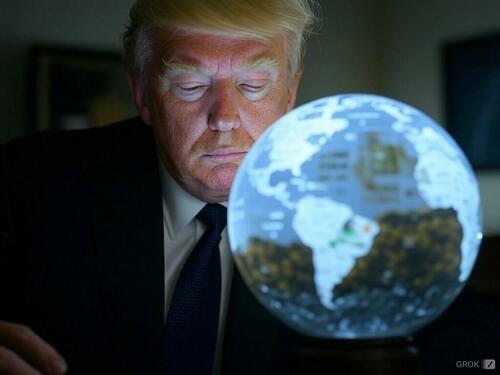
What is not broken for the moment — a tenuous moment — is the new Trump regime’s determination to correct the disorders of Western Civ, starting with the affairs of the USA, according to age-old reality-based norms of behavior and good-faith relations between the people and their government. Trust was broken and must be restored. The President-elect has assembled an extraordinary team of reformers, if they can get to their posts without subversion. And, of course, Mr. Trump himself has to evade further attempts to rub him out, to knock him off the game-board before he can take office, and then he must survive the months beyond his inauguration. So, you are correct to be nervous.
Paradoxically, Mr. Trump has to initially manage the US government as if it deserves a sense of reassuring continuity, which, in many respects it does not deserve. So many institutions and relationships between them have been perverted and damaged. How do we pretend that the upper layers of management in any federal agency — the strata who really run things below the top “political” appointees — can continue in-place as if all that perversion never happened? The Department of Justice and the FBI are filled with lawyers and agents who abused their power egregiously and went to war against the American people. The agency’s work will just have to stop for a while. The nation can probably endure if investigations and prosecutions are suspended for sixty days while the personnel issues get sorted out — who goes and who stays.
But what about the Defense Department and the CIA? The country must be able to defend itself. These departments are the lairs of the more dangerously entrenched blob actors. Both DOD and the CIA have come to be organized as racketeering operations. Both are involved in domestic money-laundering activities at the giant scale, and in rackets abroad — such as the many grifts around Ukraine, in which giant financial entities like BlackRock are partnered-in. (You know, for instance, don’t you, that BlackRock was poised to acquire control of Ukraine’s natural resource base, until Mr. Putin’s resolve ended that fantasy.) And the CIA is suspected of being deeply involved in the Mexican crime cartel operations, both around drugs and human trafficking. The imputations are sickening. The DOD and the CIA will fight desperately to preserve their perqs and projects, and to stay out of jail. But until now they have not really been challenged.
The public health agencies, FDA, NIAID, CDC, NIH, and so on have become outright mafias, with labyrinths of money-laundering channels, government grant-grifting, and pharma phuckery, not least around the still-mysterious, homicidal Covid-19 prank, with the deadly mRNA vaccine program piggybacked onto it. Their nemesis, RFK, Jr., is coming on-board to oversee exactly what happened in these corrupt fiefdoms. If you have read his books about Dr. Anthony Fauci, you know that he is adequately prepared to discover what took US public health off-the-rails. Don’t forget, also, that the entire medical profession lies in a slough of dishonor for going along with the fake-and-deadly Covid-19 treatment protocols (intubation, remdesivir, midazolam, and morphine) that killed so many people needlessly. Plus, the doctors’ dishonest demonization of ivermectin and other viable treatments, plus the disgraceful, mendacious behavior of the medical journals in the whole filthy scam. Next, consider the rickety, cruel, Kafkaesque US health insurance system that is now all but running the doctors’ practices. It is an unholy mess. What can you do but wish Mr. Kennedy God-speed in beginning to unravel it all? Surely, a lot of people involved deserve to go to prison.
For all you know, the heavyweights of blobdom might be plotting some sort of coup during the Holiday season to prevent Mr. Trump from taking power on January 20. Failure to mount a coup would actually signal some essential weakness in the blob’s own enterprise architecture. The blob has certainly tried everything so far up to an actual coup, that is, a sharp discontinuity in constitutional government — like, with tanks around the US Capitol and generals in the Oval Office. The blob’s other problem is that it has no powerful individual leader to rally behind, no one with charisma. It has only its multifarious tentacles — departments, agencies, offices, and operations — which Mr. Trump and his lieutenants can lop off in broad strokes. They can cashier generals, defund projects, shut-down offices and programs, send US Marshals into CIA headquarters in Langley, VA, to lockdown document archives while flushing out employees. Early on, the Trump team has got to assess the patriotism of individuals in these departments. Based on blob behavior of the past decade, no one’s fidelity to the constitution can be taken-for-granted.
It will surely be necessary to begin open inquiries into the recent behavior of some prominent political figures in order to demonstrate a serious intent to reform.
For just one example, Alejandro Mayorkas, the Homeland Security chief who threw the US Border wide open for four years, presents a probable cause case for treason. Perhaps the new Attorney General can convene a grand jury away from the blob-dominated DC federal court district, say in Texas where these crimes on the border were actually committed — crimes such as ordering the US Border Patrol to stand down while whole caravans waded the Rio Grande.
Attorney General Merrick Garland needs to answer publicly for his coordination of a massive DOJ lawfare conspiracy. How exactly did Deputy US AG Matthew Colangelo end up in Manhattan DA Alvin Bragg’s office? Who green-lighted the harsh prosecutions of Jan 6 suspects by Matthew Graves, in particular their long pre-trial detentions in solitary confinement? Who in the White House confabbed with attorney Nathan Wade to manage the Fulton County case against Mr. Trump and eighteen other defendants? Why did Delaware federal attorney David Weiss allow the statute of limitations run out on Hunter Biden’s 2014 and 2015 tax evasion cases? Stuff like that.
And, of course, FBI Director Christopher Wray needs to answer for the Jan 6 DNC / RNC pipe bomb caper, and the roles of “confidential human sources” in the Jan 6 Capitol riot — including the antics of the notorious Ray Epps. Plus, the three years of RussiaGate and his cavalier use of the FISA Courts. Please subpoena SC District Judge James Boasberg on that, too, while you’re at it. It will not take many inquiries like these to get the point across. The point will be that after many years of absence, consequence is back on the table for those who abuse power.
During the transition — Nov 6 to Jan 20 — Mr. Trump has equivocated a bit about his intentions to bring back consequence in federal operations. On one hand he claims he’s “not interested in retribution,” while on the other hand he has named appointees such as Kash Patel at FBI and John Ratcliffe at CIA who are intimately acquainted with the illegal activities in those places and on-the-record as eager to set consequence in motion. It’s hard to imagine they will demur from getting answers about what has been going on and who is responsible, and take corrective measures.
If he makes it through confirmation, it may be less difficult for a Defense Secretary Pete Hegseth to straighten out the Pentagon. The military is much more explicitly hierarchical, and orders are orders. Generals and bureaucrats will be ordered out of the building. But then there are large dark pools of activity hidden from the public, things like DARPA and its many offshoots, that may be harder to penetrate. You must imagine that there are operations hidden even from the SecDef. We keep hearing that the Pentagon can’t pass an audit and can’t account for trillions of mis-spent dollars. Guess what? Someone (or many someones) can be court-martialed for that. Again: consequence returns. Suddenly things are done correctly. Perhaps even a lost sense of honor is restored.
The Fiscal Abyss
Who knows what Elon & Vivek’s DOGE group can accomplish? But there are hard limits in the fiscal whoppers like Social Security, Medicare and Medicaid, and veterans benefits that won’t yield much. Blogger David Stockman, former head of the Congressional Budget Office, estimates that even firing three-quarters of all federal employees would only save about $700 billion in savings, which is not enough to avoid a debt death spiral. The carried debt alone could sink whatever else Mr. Trump seeks to accomplish, especially as it can morph into a lethal currency crisis at any time — a runaway inflation and / or collapse of the bond market that would put a lot of people and enterprises out of business, bringing on a new great depression.
There’s always talk about “growing” our way out of debt. I doubt we will be able to do that in the proposed way, based on economic dynamics we’ll get to further below. In his first term, Mr. Trump made noises about defaulting on US debt. I think you will hear chatter about doing just that in the early days of 2025. Though it sounds horrendous, default will happen one way or another: either an honest repudiation of treasury paper (Sorry, we just can’t make the payments anymore), or by allowing currency collapse to do the dirty work for us (Sorry, but our money is worthless. Here’s a billion dollars. . . enjoy the bagel you get for it).
Much of the rest of the world is in similar straits debt-wise, especially Europe and China. The Bretton Woods system for regulating world money has been brain-dead for many years. It’s not hard to imagine something replacing it, including the US dollar’s status as the world’s reserve currency (with all its exorbitant privileges). It remains to be seen what role, if any, cryptocurrencies might play in world trade. Many people are wowed by Bitcoin’s journey above $100,000 lately. I’m still not persuaded that it’s anything but a classic bubble in a speculation that represents nothing — except maybe the electricity expended in processing the math attached to its “creation.” A blogger friend makes this interesting point:
What will matter is that one Bitcoin transaction is equivalent to about a month of electricity for the average US household. As Bitcoin grows, energy “consumption” grows exponentially. Note, I said CONSUMPTION, NOT PRODUCTION. If you believe in infinite cheap energy fueled by infinite free money and debt, then all the power to you! No pun intended. . . . — Wendy Williamson
For all the “wow,” Bitcoin still lacks the principal properties of true money. It’s not a practical medium of exchange (buying stuff), it’s not a useful store of value (with its periodic crashes and zooms), nor a reliable index of prices (ditto). To me, it looks like a fugazy that has made a small number of people very rich within a limited window of history. Naturally, the people who got rich, who converted their Bitcoins into villas, yachts, and shares of Nvidia, are infatuated with Bitcoin and the phenomenon of crypto. If there is one thing that might characterize the new times we are entering, it will be the recognition that real things have more value than fake things. We have been traumatized by fakery, and going forward great effort will go into identifying it. Our survival depends on being able to discern the fake from the real.
Money and Economy
Does the world really need a certified universal money agreement? Nothing like Bretton Woods existed until eighty years ago, and it came into being only because the USA so dominated the globe after a ruinous war in Europe and Asia it could command the world’s obedience — at least the parts that weren’t communist. Before that, currencies, monies, and commodities existed, of course, and people took calculated chances trading in them. Usually, but not always, one nation’s currency dominated for a while, as the pound sterling did before World War Two. But paper currencies are a relative novelty. The US only started using paper money in the 1860s. When “money” was mostly gold or silver coin, exchange rates were easy to determine by the purity and weight of a coin. When paper entered the scene, bankers, speculators, and merchants had to do their own due diligence to discover whether X-tons of iron ore, tons of coal, or wheat were worth trading for X-amount of yen, deutschmarks, pounds sterling, and dollars. Those quandaries birthed hedging in currency and commodity trades — a device now wildly perverted, deforming the dynamics of risk and price discovery in everything.
We are probably headed back into that world of diverse monies with inherent risks, part and parcel with a multi-polar world of regional hegemons. The US dollar can no longer act as the universal collateral guaranteeing all transactions. Hence, the trade in debt, bonds, and borrowing re-acquires layers of risk absent for a long time. Government borrowing — issuance of sovereign bonds — necessarily declines in that milieu as moral hazard reappears in financial affairs and governments can no longer promiscuously float their spending on debt. Other countries have already discontinued their purchases of US Treasury paper. Where will the customers for US debt come from? (Answer: nowhere.) It’s just another way that nations and their people are forced to get real in a new disposition of things.
For now, it has probably been demonstrated that central bank digital currencies are unlikely to work. (Nigeria’s eNaira program, the world’s first large-scale experiment in CBDCs flopped miserably.) Along with the tyrannical surveillance issues, too many citizens rely on transacting business in cash, and if the cash turns no-good, they will find other instruments for transacting, perhaps even things as crude and straightforward as gold and silver, with no counter-party risk, no leverage, and no bullshit attached. To me, though, reversion to hard currency would imply a devolution to far less-complex economies and much lower standards of living.
All that runs counter to the current excitement about technological advances compensating for declining systems of modernity — derived from the 20th century religion of endless, limitless progress — creating evermore available (fake) capital. These are the expectations for Artificial Intelligence, advances in “green technology” (especially enhanced electric batteries), next-generation nuclear power, and energy tech not yet achieved but dreamed about such as atomic fusion and zero-point energy.
Oil
For now, the primary resource of our economy remains oil. All other technologies, including nuclear and “green” tech, still require oil for the production of their hardware and maintenance. US oil production reached an all-time high in late 2024 at 13.6million barrels a day — way higher than the old, pre-fracking era “peak oil” figure of 10-million b/d from 1970, and superficially impressive. Fracking has made all the difference the past two decades, but it is not a permanent installation in the human condition. The continuing production increase has come from enhanced drilling techniques even while the supply of tier-one “sweet-spots” in the Permian Basin of West Texas has markedly declined — and the Permian Basin is the last redoubt of economic shale oil (oil economically worth recovering) in the USA.
Mr. Trump has promised loudly and often to “Drill, baby, drill.” Aggressive drilling and opening remaining frontiers like the Arctic National Wildlife Refuge to oil production could extend America’s oil abundance on the short end, but there are no meaningful “exploration” prospects left in North America beyond that. We’ll be fooling ourselves. It’s been a nice ride, but the end is in sight.
In the Permian Basin, the best drilling locations are increasingly rare as the more productive areas have been exploited. Production In the Permian has declined by 15-percent since 2020, according to data from Enverus. Break-even costs are rising. New well productivity per lateral foot is declining. ZIRP is bygone and the cost of capital (interest on borrowed money) is up with inflation. From 2009 to 2020 — the ZIRP years — investors flocked to shale oil stocks since they couldn’t make a buck on bonds. But the shale producers had trouble making money, even though they produced a lot of oil. Many went bankrupt. After that, investors grew shy about investing in shale oil. Going forward, the capital might not be there for these capital-intensive operations.
With the old oil — say, conventional oil in Oklahoma, 1950, where you just banged a pipe in the ground and oil gushed out — the cost of drilling a well was around $500,000 per well (in today’s money). They produced thousands of barrels a day for decades. Shale oil wells cost between $6-million to $12-million per well, with horizontal drilling and fracking (utilizing vast amounts of water trucked-in, plus chemicals and fracking sand to keep the fractures open). The shale wells produce far less per day than the old conventional wells and they decline by over 50-percent in one year. After three or four years, they’re done. Do you see the difference?
Higher oil prices are required to justify new capital expenditure. Yet day-by-day the declining American middle-class steadily loses its ability to pay more for oil and individuals and households go broke under the strain of higher prices. The overall dynamic of our economy starts to wobble. Fewer people can qualify for car loans, which is mainly the way American acquire cars. Car-makers are stuck with excess inventory. Eventually the car-makers’ business model fails. And, by the way, it ought to be clear by now that we will not transition from oil-based cars to all-electric cars — surely not at the same scale of mass ownership. Electric cars just cost too much.
What happens when mass motoring becomes incrementally less mass, less democratic, something only for the well-off? Answer: It stops. It becomes a focus of resentment and rage. It loses its government subsidies (highway repair, etc). It also leads to the demise of America’s premier living arrangement: suburbia. I have written about this quandary for years. It has been hanging over America’s head, and we are unable to imagine how it plays out — mainly because of the titanic sunk-costs involved. We’ve invested so much of our historic cumulative wealth in building the infrastructure for this living arrangement that letting go of it is unthinkable. Yet, it is already becoming severely dysfunctional. And, of course, as that happens, its components — the tract houses, the strip malls, the office parks — will lose their value, meaning that it will become ever-harder for many people to successfully cash out of it and move elsewhere.
And even so, where would that elsewhere be? That problem is exacerbated by the ruinous condition of American cities and their future trajectory. Many US cities have already failed outright — Detroit, St. Louis, Cleveland, Baltimore, Buffalo etc. They are abysmally governed and falling to pieces. They are filled with purposeless humanity, lost souls, dangerous criminals, and ever-fewer places of employment. Even the arguably still-successful cities — New York, Boston, Miami — have attained a scale of operation that is not sustainable, not consistent with the resource and capital scarcities to come. They will have to contract, drop services, lose population — and the process will be very messy. Eventually, they’ll be smaller, but they still occupy some of the best geographical sites, so they will not disappear altogether. The contraction will take a long time to resolve.
For the present, that leaves the thousands of small towns across America that have been drained of vitality and investment for decades. Despite the damage, they have two big virtues: they already exist at a scale more congenial to redevelopment in a resource-and-capital constrained time; and many of them are geographically proximate to places where food can be grown for their own support. We will discover that this is where the action will move to. This is where much of the remaining population will resettle as the giant cities and suburbia enter their epic decline.
More Change Than You Bargained For
The “Golden Age” euphoria is palpable in these weeks before the Trump inauguration. Wall Street is in a rapture imagining a renaissance of corporate enterprise as a punitive regulatory regime lifts. But, just as gigantic cities tend to fail on the issue of scale, the economy as a whole is in need of reorganizing at a finer grain of enterprise. Gigantism itself, gigantic corporations with their tropism for monopoly, have become increasingly ruinous for communities, households, and individual lives in our time. Americans need more autonomy in their economic lives. The trouble is, we might have to get there the hard way — via a general crash of things organized at too large a scale, which would force the necessary rebuild at a smaller and more local scale. This implies a coming second great depression.
It’s not hard to imagine such a crash occurring in the first year of a Trump regime. For one thing, there are surely nefarious parties and persons who would like to see it happen, who might even seek to engineer a financial train wreck for revenge against Mr. Trump and his followers. Anyway, a severely overvalued stock market is begging for correction. Ditto the housing market (and the over-valued collateral it represents) that so much of finance rests on. Too many banks are insolvent. The debt quagmire ensures that government can’t rush to the rescue as it has in past emergencies to bail out the banks without destroying the dollar.
You might also wonder about the proposition laid out in David Rogers Webb’s book, The Great Taking, about the meticulously planned scheme for central bankers to seize much of the collateral in the world, meaning all your stuff. Sounds a little grandiose and preposterous, perhaps, but the fact is that the regulatory authorities of Western Civ have rewritten the banking rules stealthily over the years so that anyone with a bank account is now considered just a low-order creditor whose assets can be taken in the event of a banking emergency. Your savings are just labeled “collateral,” and your “ownership” of the assets is not what you thought it was. The scam seems fantastic, but the rules are in place, waiting to be sprung. Mr. Webb’s concise 99-page book is available free as a pdf HERE.
Of course, a global implosion of equity and bond markets would be the end of financial life as we’ve known it, and none of the abstract chatter about banking rules takes sufficient account of the grotesque social disorder that would attend such an event, so any Great Taking might end up being beside the point — the point being that everyone is broke, no one can transact, and things get awfully dire. But we get a bit ahead of ourselves going up that path. So, let’s return to things we know about.
Mr. Trump’s proposed economic reforms have inescapable overtones of contraction. Paring down the federal government workforce may have many benefits, but it would likely cause a depression in the DC Metro area as jobs are massively eliminated, and the economic damage would radiate through the rest of the country as departments are trimmed and shut down, and the money flowing out of them stops. The effect of a tariff campaign could hurt American business in the short term. Import replacement is a laudatory goal, but it’s liable to be a rough road getting there. Supply lines will break. People and businesses will not get the things they need to do produce goods. It takes time and capital to set up new factories. The tendency will be to run production with robots as far as possible — so, where will the people earn a living? Robots will not become consumers. You must also wonder more generally whether it’s really possible to reenact the industrial orgy of the mid-20th century. Detroit will not be what it was in 1962.
“Joe Biden” leaves behind an economy already auguring-in, concealed by monumental federal spending of money created out of thin air in the months leading up to the 2024 election to cover-up the failing private US economy. Also, all of the official reporting about jobs in 2024 was fake in order to juice the election for the party in power. US Government outlays for the year were $6.752 trillion against revenue of $4.919 trillion. Government can’t solve the problem of mass joblessness by giving everybody government jobs, and Mr. Trump is not philosophically aligned to that sort 20th century Big Government action. Anyway, too many jobs today are crap jobs toiling for merciless companies who mistreat their workers, so the very meaning of work has been degraded to a new kind of slavery. Plus, too many Americans do not work at all, but subsist on government hand-outs or on crime. How does this change?
First, it doesn’t change without the nation going through a period of disorder, discontinuity, and distress. When it does change, the change will be systemic and emergent. It will not come from any top-down government or managerial process. It emerges from the circumstances that reality presents — specifically, the need for people to support themselves, to make themselves useful to their fellow humans, which relationships form into networks of business and work that become a social ecology, a community.
So, the second Trump term could usher in a period of deep economic hardship as we try to figure out how to remake an American economy and rebuild those local ecologies of business. Can Mr. Trump assume a role anything like Franklin Roosevelt did in the 1930s? A paternal voice speaking directly to the people and offering them reassurance in a troubled time? They are obviously very different personalities. Also, the lingering political opposition to Mr. Trump is far more noxious on the Left than anything FDR faced from the Right in 1933. Today’s Left is still functionally insane, sunk in Marxian-Woke delusions, race-and-gender animus, and an intemperate libido for power, all of it boding ill for political stability.
Americans are used to relying on faceless, distant authorities to take care them, to solve their problems: Social Security, Disability, Medicaid, insurance companies, courts. It all works very poorly now, and before long a lot of it may not work at all. We will have to take care of each other. There have never been so many single-person households as there are now. Loneliness and anomie are epic. When the Boomers are gone, that will likely be the end of nursing home care and assisted living at the cost of many thousands of dollars-a-month. The Boomers’ replacement generations are not nearly as wealthy. They missed the window for being able to buy McMansions that could be liquidated for millions to support end-of-life care. We’ll probably see the rise of households made of unrelated people. But the default setting for humans is the family and the extended family.
Some human relations that were common in earlier eras of history, and absent in our time, could return. A little over a century ago, ten percent of the people employed in America were household servants, including what were then middle-class households. Today, only the very wealthy have servants. What hasn’t changed is that people need a place and a purpose, and a purposeful place in a household is not necessarily a bad deal in a civilized society. We just haven’t experienced it in many decades and many Americans would probably find the proposition ridiculous. Yet too many have no place in society and nothing to do, including activities that might be considered duties to one another.
Many towns in the 19th century had institutions called the Poor Farm. Sounds terrible, perhaps, but it was a way of providing a place and real duties for people who had nowhere else to go and nothing to occupy them. It was generally organized as a local charity. Residents were expected to work to their ability, raise their own food in gardens, take care of livestock, do laundry and cleaning chores. Today, that might be considered “cruel,” but really, is it as bad as just letting many thousands camp-out on the streets, sunk in drug addiction? What it requires is the political will to organize useful, properly-scaled institutions around these needs. To get there, we must drop a lot of ideological pretenses.
We face very serious problems with agriculture organized at the gigantic scale, utilizing multi-million-dollar machines (usually mortgaged), giant loans to put in crops, huge “inputs” of chemicals and fertilizers. That is probably coming to an end, too, despite the current techno-narcissistic fantasies of Agribiz. We’re probably going to need more human beings working directly on farms, smaller farms, with fewer giant machines, less borrowed money for putting in crops, and fewer chemical inputs. Which is to say, we’re probably going to see a larger percentage of the population at work growing our food than has been the case for a long time. I suppose it’s hard to grok our society becoming reorganized so differently, of reviving ways of living and working together that are consistent with human nature, proven over time, but considered out-of-date now.
Obviously resurrecting relations like these requires major changes in our national psychology. Today, it is impossible to persuade a lot of citizens that they need to do something useful for a living. Or, to look at it differently, that there might be activities to fill their days that would interesting, satisfying, and rewarded with pay — rather than just loafing, getting high, and watching canned entertainment. Today, we lack countless occupational niches in society that used to allow people of very different abilities to find a place and a purpose, especially, now, people of low ability. If I am correct that the macro trend is to re-scale our economy and re-localize it, those places and purposes can return. It will probably also require a return of the eternal verities, too, as a means of managing social relations: truth, beauty, liberty, brotherly love, trust, fairness. . . conditions and behavior that we should at least agree to aspire to in a common culture worthy of our allegiance.
I doubt that the incoming Trump administration sees things developing in the direction of downscaling, decomplexifying, and localizing. Rather, they seem to expect ever more grandiose enterprise, at least in what’s known as the private sector, even while they pare down government. But, really, everything in the everyday life of this nation will have to scale down and happen differently. We’re going to need fewer giant entities like Walmart and more local commercial networks of small businesses geared to local communities. As you may have inferred, I believe that circumstances will deliver us to that new disposition of things in any case, whether political leaders agree or not. If Mr. Trump is wise, he will recognize the trend and go with the flow.
Other Parts of the World
As I write, governments are falling all over the place. Olaf Scholz cannot form a governing coalition in Germany. In France, Emmanuel Macron’s ruling faction lost bigly in snap elections last summer with no clear majority for any coalition, and also in the EU parliamentary elections. Both countries are using lawfare to defeat their opponents. Mr Scholz’s and his allies are trying to outlaw the rising opposition Alternative for Deutschland (AFD) party, especially after the AFD showed growing strength in state elections in Saxony, Brandenburg, and Thuringia. The Paris prosecutor’s office is trying to nail Marine LePen on embezzling EU funds to pay staff salaries in her National Rally Party.
Germany, the largest economy in the EU, has been busy committing suicide for the past decade. The country shut down its nuclear power reactor fleet entirely and went all-in for a “green” energy program (wind and solar) that has fallen far short of being able to supply its needs. It had just gotten ready to receive a reliable supply of cheap Russian natural gas in 2022 when somebody — probably the USA — blew up the Nord Stream One and Two pipelines. Joe Biden declared in so many words that he was going to “stop” the Nord Streams months earlier, so why not believe him? The Germans just rolled over for what would normally be construed as an act-of-war against it, by a NATO ally no less.
Consequently, overnight Germany’s advanced industrial economy, its automakers, chemical companies, machine tool-makers, became uncompetitive in global markets and the German economy entered a slow death spiral. Europe is now supposed to be happy to get American liquified natgas, which is much more costly to transport and offload than Russian pipeline gas would have been. France was only marginally better off with its robust nuclear energy production to supply electricity, but it, too, lost access to cheap Russian natgas needed for industry and home heating.
Meanwhile, the other nations of the EU have all to one extent or another joined the European suicide pact. The EU has been at war against its own farmers for years for reasons that appear completely insane — perhaps driven by Klaus Schwab and his World Economic Forum. The regulatory architecture of the European Commission is crushing business under its “green” energy and climate change mitigation agenda. Geert Wilders’ Party for Freedom (PVV) unexpectedly won the most seats in the last election, but not an outright majority, and could not form a working coalition. Wilders did not become prime minister —the job was assigned instead to one Dick Schoof, a career bureaucrat who most recently ran the Netherlands’ Intel service.
Canada, entered political limbo in mid-December when Deputy Prime Minister and Finance chief (and WEF board member) Chrystia Freeland suddenly resigned and Prime Minister Justin Trudeau looked like he was fighting for his political life in parliament. Mr. Trudeau had only days before made a pilgrimage to Mar-a-Lago for talks with Donald Trump, who mocked him most severely down there, calling Canada “our fifty-first state” and referring to Mr. Trudeau as “governor.” The Canadian dollar has been tanking since then and stands at 69 cents to the US dollar as I write. Mr. Trudeau will be gone early in the new year at the latest. He’ll be replaced by the Conservative party leader, Pierre Poilievre, who demonstrates an ability to think straight.
The European Union regulatory overlayment has become an intolerable burden for the EU member nations. The EU seemed like a good idea at the time, and for many years basic operating principles like a common currency (the Euro) and the Schengen Agreement (free movement of member state citizens and goods across national borders) made daily life easier. But in recent years the EU bureaucracy adopted a set of insane polices: the programmatic destruction of farms and farmers; mass unregulated immigration from third world failed states; and antipathy to petroleum resources for the sake of debatable climate change. Aggravating all this is the unelected EU Commissioners’ lack of accountability to the public. Other technical issues, such as the EU’s lack of fiscal control over individual members and the problems that causes for bond issuance appear irresolvable.
Once before, in 2012, financial turmoil has threatened the EU’s existence. But that crisis — the collapse of Greece and its ramifications — got “papered over” with bail-outs and accounting fraud. Now, Europe enters an era not just of critical financial imbalances, but of severe dislocations in the on-the-ground economy of real production. The flood of migrants continues and their aggressive antagonism to age-old European culture is on the rise with calls for Sharia law and a European caliphate. It’s getting to look like a tragi-farcical reenactment of the Mohammedan conquests of the Middle Ages. It’s draining EU members’ treasuries while they go broke from de-industrializing. And countless humiliations are heaped on the people: mass murders, beheadings, constant insults, street violence all over and, just last week, the Christmas market murders in Magdeburg. It’s at a breaking point. As Europe watches Mr. Trump successfully commence deportations, Europe will eventually follow — but not before a tumultuous period in early 2025 when rebellion sweeps away Leftist governments. The European Union could be swept away with them. Borders will harden, national currencies might return, and drastic realignment awaits.
The United Kingdom looks like a lost cause due to the utter collapse of the conservative party, leaving Labor temporarily alone on the field, with the monumentally incompetent PM Keir Starmer in charge and an all-out Orwellian regime severely abusing the indigenous British people while it coddles hostile immigrants. That will not last a whole lot longer. Starmer will be chased out in the first half of 2025, just as Liz Truss (remember her?) got dumped in 2022. Waiting to enter at stage-right is Nigel Farage, a genuinely charismatic leader who is destined to become Britain’s Trump. After successfully leading the Brexit charge, he sojourned in the political wilderness like Churchill did between 1929-39. Now he leads the Reform UK Party, which is in the process of utterly eclipsing the broken Tories. Look for Farage to make his move quickly in 2025.
Then there is the woeful situation in Ukraine. I’ve written about it often and will recapitulate it as succinctly as possible: The Ukraine War was an American neocon project to destabilize Russia and probably an attempt to gain control of its resource assets. Mr. Putin refused to get rolled and fought back. It has been a hugely costly disaster for Ukraine in blood, capital, and infrastructure. Not a cake-walk for Russia, either. But Mr. Putin will probably attain his objectives, which are: annexation of Donbas and Crimea and establishment of what’s left of Ukraine as a neutral, non-member of NATO.
Mr. Trump is eager to end what he calls “this stupid war.” The catch is, how can he settle it expeditiously without appearing to capitulate? Mr. Putin will not budge from retaining Crimea and the Donbas provinces (“oblasts”). That is the condition for even entering talks. The humiliation associated with this project should be all Joe Biden’s, and in some respects certainly will be when his family’s entanglements and machinations are fully exposed, as they are certain to be.
Mr. Trump and Mr. Putin will solve the puzzle by pretending to negotiate over the port of Odessa, which will eventually be awarded to the rump Ukraine so it can have access to the sea for its essential grain shipments. They’ll tussle for a while over that but it will be all for show. The war will end. Ukraine will finally hold elections and Volodymyr Zelenskyy will be cast out like a dog that has peed on the rug too many times. I doubt he will survive the year. Both America and Russia pony up money to rebuild Ukraine’s critical infrastructure, but not much more. The world will come to understand exactly what happened. NATO will be a shadow of what it was, if it does not collapse altogether due to the rising political upheavals all over Europe.
The Middle East
I am not on the bus with the mob shouting about Israel as a perpetrator of “genocide.” Our own General Sherman put it succinctly 160 years ago: War is hell. Hamas should not have started one on October 7, 2023. For that, the Palestinians got hell. Hamas fighters should not have (literally) dug itself in amongst the Palestinian civilians of Gaza, with its labyrinth of war tunnels that the Israelis had to destroy if there would be any end to the strife emanating out of them.
The essential problem in that corner of the world is that the region cannot support the huge and still-growing populations of most of the Arab states in it. It is mostly desert. The fantastic wealth of the oil age combined with other circumstances, such as the increase in grain production, to grow these populations. Tragically now, all that has reached a limit and things are going in the other direction: toward collapse. This slow-motion collapse expresses itself in political friction, mass migration, violence, and religious zealotry. The Jihadis are serious about murdering non-Muslims. Considering the action in Europe lately, the truculence of Muslim migrants towards their hosts there, it’s obvious that Jews and Christians are on equal footing as targets.
The population Israel of Israel is 9.4 -million. The total population of Palestinians worldwide is estimated to be around 14.8 million as of mid-2024. This includes Palestinians living in the West Bank and Gaza Strip, within Israel, and in the diaspora across various countries. The population of countries adjacent to — Egypt, Jordan, Lebanon, Syria — is 145-million. Much of that Arab population subscribes to annihilating the state of Israel, and declares as much publicly all the time. Is Israel not supposed to take those threats seriously?
Considering these odds, are you shocked and offended that the United States is an ally of Israel? Do you think that the United States has no strategic interest in any counter-balance to opposing interests in the Middle East? Grow up. The American Woke-Marxists want you to think that this relationship is illicit, unjust. They want you to hate the Jews and hate Israel. You’d better ask yourself: who do these Woke-Marxists serve? Not our interests, not American interests.
Israel has managed to make its tiny desert country blossom over the past seventy-five years while also building a manufacturing and tech economy. Due to the constant threats against it, much of the wealth generated by that economy must be directed into the Israeli Defense Force (IDF). It is quite an accomplishment for this tiny state to stand-up against so many enemies. They have won two major wars against them in modern times as well as many periodic border clashes, intifadas, and skirmishes. Their enemies are deeply resentful and probably jealous of Israel’s economic success.
The Oct 7, 2023, rape, torture, and murder attack by Hamas prompted Israel to mount an existential defense against an obdurately and garishly murderous enemy. Israel won the Gaza Strip territory from Egypt in the 1967 War. In 2005 it turned over governance of Gaza to the Palestinians. Among other things, the Palestinians could have turned Gaza’s twenty-five-mile-long beach-front into a premier Mediterranean resort. Instead, the Hamas government used the international aid funds they received to build miles and miles of war tunnels. Bad choice. They used Gaza as a launching pad for missile attacks and intifadas. More bad choices. 10/7/23 was a crossed red line. Now there is no more Gaza. The civilians will have to find somewhere else to go, and if their Arab neighbors won’t take them, then blame their Arab neighbors. They have been cast out for atrocious behavior.
The Jihadis’ publicists want you to think that Israel has behaved badly. No doubt, the action by the IDF in Gaza was brutal. War is hell. In war, everywhere and always, soldiers act savagely. Americans did, at times, in Vietnam and Iraq. It is the reality of war. One lesson is that wars should not be started casually. Israel’s motive in this war is to put the war parties of its enemies out-of-business. It is close to succeeding now, with Hamas scattered, Hezbollah cut off from its sponsor, Iran, and Assad gone in Syria. Israel accomplished this with the “Joe Biden” regime pretending to support both sides in the conflict and finally having less influence than ever over the outcome. This is where things stand in December, 2025, but it is a very lively game-board, and there is much potential for new action and the entry of other players, which we’ll turn to now.
Suddenly Syria
Well, that was fast! Took twelve days (Nov 27 to Dec 8). Phhhhht!!! Assad, gone (to Russia). How’d that happen? Begin with the population problem I cited above: the region is poor. Expanding population against a contracting resource base will create great political and social stresses. Syria’s population grew dramatically from 7-million in 1972 to 22-million in 2022. Syria is a large country with distinct territories. Its easternmost region bordering Iraq and Turkey, Jazira, with the city of Raqqah, straddles the Euphrates River, a grain-growing corridor that used to feed the Syrian people. Many years of drought and botched irrigation projects have wrecked farming there. That was one factor in the mass migrations to Europe the past decade. Altogether, 6-million Syrians have fled the country since the Arab Spring in 2011. Jazira is also the location of Syria’s oil, which was grabbed by the US in 2019 when the country was racked by civil war. The region is a cultural crossroads, with a significant Kurdish population, bleeding over to Greater Kurdistan into Iraq and Turkey.
Long story short: Assad’s Syria was badly weakened by food shortages, revenue shortage, and long-running civil war. He could barely pay his Army, and when the Hayat Tahrir al-Sham (HTS) rebel forces pushed across the country this fall, his soldiers melted away. HTS has its origins in al Qaeda, and al Qaeda has its origins in the US intel blob and its neocon strategists. You can be sure that the US was involved in rooting out Assad. As we have seen before, these kinds of operations tend to be double-edged swords, which end up stabbing America in the back later on. In this case, imagine that by chasing Assad out we may have succeeded in turning Syria into Jihad Central of the Middle East.
As soon as HTS was in control of Damascus, the capital, Israel sent its air force in and destroyed every military target, airfield, tank park, munitions depot in Syria so that it would not fall into the hands of Hezbollah, Israel’s Iran-backed enemy. Israel controls a small area of southern Syria near the Golan Heights. Israel had already done severe damage to Hezbollah earlier this year by methodically killing off its leadership, one-by-one. The exploding pager op also did enormous operational damage to Hezbollah. For now, Israel benefits from broken Syria. Iran has lost its geographical conduit for arms supply to Hezbollah. The HTS forces are Sunni and Hezbollah’s sponsor, Iran, is Shia, with all the built-in conflict that implies. All of a sudden, Iran has lost its influence in this region adjacent to Israel, the enemy it declares it wants to “wipe off the map.”
The Turks were involved in the Syrian regime change, too. Turkey currently hosts millions of Syrian refugees from the chaos of the Syrian civil war. The Kurds in Syria are also a problem, linked to the PKK, a terrorist terror group inside Turkey. Turkey’s pugnacious president, Recep Tayyip Erdoğan, pivots between its alliance with NATO, its off-and-on strategic relations with Russia, and the Arab world with its cultural affinities. Turkey is a disgruntled NATO. For decades, it was openly and often derided by other nations in the west as “the sick man of Europe.” Yet, it controls the entrance to the Black Sea, which has always been a problem for Russia — they have gone to war several times — though Russia engages in development projects in Turkey these days.
Don’t forget, Turkey’s Ottoman Empire controlled all of the Middle East and North Africa from the 16th into the early 20th century and its influence ranged into Europe as well. This was the time long before oil wealth juiced the Arab world. Populations were sparse then across what was then called The Holy Land. The indigenous Arabs still wandered the desert on camels and lived in tents. The Ottoman Empire collapsed in the First World War, and what you see on-the-ground over much of the region are artificial boundaries created by the British after the war for administrative efficiency. Mr. Erdoğan may harbor ambitions for Turkey to once again play a larger role in world affairs. It has the region’s largest standing army. For now, Turkey and Erdoğan enjoy somewhat enhanced regional influence. The counter to him has been the US’s penchant for creating failed states via CIA involvement with rebel and Jihad movements. Mr. Trump has dropped the hint that he’s inclined to keep the US involvement in Syria to a minimum. He begins his administration with a declared aversion to all the world’s current wars.
I’d forecast the HTS government not being able to control much of the country and a continued arc toward failed nationhood, with friction and violence between many of the different groups still residing there. I doubt Israel wants to try to control it, since it is an obvious quagmire. Russia appears to be bowing out of direct involvement, too, but is rumored to be negotiating with HTS to maintain its presence at the Khmeimim Air Base and the Tartus Naval Base. The macro trend in many parts of the Middle East is a return to pre-modernity. The last hundred years of jet planes and Range Rovers will look like a strange, anomalous blip in history.
China
Whatever is going on in China, her leaders like to play the long game, looking ahead decades, fifty and a hundred years, while everyone else struggles to strategize from month to month. It doesn’t mean that China comes out a winner, though. Some of that long game is just hubris and pretense. China has plenty of problems. It developed into an industrial colossus overnight, and now the global techno-industrial economy it found such a big role in is wobbling, especially in Europe, which puts a huge strain on China’s export-oriented system. Its financial architecture has always been janky because CCP is so entangled with the banks, bourses, and giant business enterprises — and if it doesn’t like how things are going, the Party just pretends that everything’s great. Nothing can be allowed to challenge the CCP’s dominance. Eventually things break, though, and the Party has to create some new narrative to explain the breakage.
Lately there are rumors of mass layoffs, and of many young people leaving the cities to return to the countryside. The population is skewed to the elderly, due to the many years of China’s one-child policy. There is, of course, the disastrous real estate bubble which continues to destroy the savings of households, since many Chinese did not trust banks or stock and bond markets, and instead invested in enormous apartment complex property development projects have been failing one after another. The CCP’s response has been to screw down CCP control over the people and their activities ever-harder. The party fears its own people and no regime has a guarantee to go on forever. Expect turmoil there in 2025 as economic depression creeps across the global economy.
America’s problems with China over trade and manufacturing are likely to be eclipsed in 2025 by the gross intrusions and subversions that China has been allowed to make in US institutions and our economy with the assistance of the “Joe Biden” administration. The Chinese have infiltrated America’s research universities, telecommunications (especially the hardware for cell phones and 5-G microwave transmission), US Intel, and the corporate sector, stealing intellectual property and our manufacturing secrets. And, of course, China has deeply involved itself in elected officialdom — the Biden family’s grifting operations and Rep Eric Swalwel’s romance with the spy Fang-Fang, among the most notorious. Senator Diane Feinstein employed a Chinese spy as her limo driver and go-fer for twenty years, including the years 2009 to 2015 when she chaired the Senate Intelligence Committee. You can be sure that Congress is well-larded with Chinese money and the influence it buys. Expect to find out a lot more in 2025. It is one of the things that binds elected officials so tightly to the DC blob.
Two other matters involving China require urgent attention and the waiting Trump admin is already talking about them.
One is China’s large, recent purchases of US land, both prime farmland and real estate around US military bases. It looks like they are going to be ejected from these holdings, with or without compensation is not known yet. We might see inquiries as to how these purchases were allowed to happen.
The second issue is the number of Chinese nationals, especially men of military age, who came across the border along with the millions of other illegal aliens that “Joe Biden” allowed into the country with zero vetting. In fiscal year 2023 — Oct 1, 2022 to Sept. 30, 2023 — that number was about 24,100. In fiscal year 2024 it was 24,400. You should assume that US intel knows something about some of them, but not most of them, and what they are up to here. Several Chinese “police stations” — that is, offices set up in US cities to control Chinese migrants in the US — have been discovered and busted the last several years. And then there was the case of the Chinese high-altitude “weather balloon” (actually suspected of being a military surveillance balloon) that the “Joe Biden” admin allowed to sail completely across the USA from the Pacific to the Atlantic before shooting it down offshore of the Carolinas.
These Chinese activities around the USA in aggregate suggest a kind of stealth warfare aimed at eventually getting control of the North American continent and its resources. This would be consistent with fifty-to-a-hundred-year long-range strategic thinking. And it was apparently working pretty nicely until the elections of 2024. It should be pretty alarming, but somehow the alarm bells have not gone off until a couple of months ago. Questions, anyone?
I’d forecast that the US and China will not go to war with China over Taiwan in 2025. It is too much of a losing proposition for all concerned. Both China and the USA will be preoccupied with domestic problems and trade negotiations in the year ahead.
A Few Other Odds and Ends
Keep your eye on Argentina and its president, Javier Milei. Argentina was the world’s seventh-wealthiest nation in the early 1900s, and from 1930s on, after many coups, the country slid into chronic decline, badly aggravated by the long-running dictatorships of Juan and Eva Peron, and followed buy decades more revolving military coups, Peronista governments, and neoliberal finance mischief that left the resource-rich nation broke.
Enter Javier Milei (Mee-lay) in 2023 as Argentina’s “anarcho-capitalist” president, who ran the promise to “take a chain saw” to the parasitical bureaucracy. In year one of his admin (essentially 2024), Milei got rid of 35,000 government employees and balanced the budget for the first time in decades. Inflation is finally falling. The Argentine people have awakened from the successive Peronista / neoliberal zombie comas they have been in for decades. Prediction: in 2025 Argentina sets the pace for the revolution in Western Civ government. Melei has another successful year in downsizing oppressive, useless bureaucracy. He begins a pioneering national nuclear power program. Argentina begins to emerge as a major player on the world stage.
El Salvador is ruled, shall we say, by the eccentric and very interesting President Nayib Bukele-Ortiz (known simply as Bukele), now in his second term. His campaign against gang violence that made El Salvador such a savage place has produced spectacular results. His new “Terrorism Confinement Center” is one of the largest and most modern prisons in the world. It was built to house 20,000 inmates. He has arrested an estimated 86,000 hardened gang-aligned criminals. El Salvador has the highest incarceration rate in the world — which is what happens after allowing criminal gangs to hold the country hostage for decades. From 2022 to 2023, the murder rate fell by approximately 69-percent. (Data for 2024 is not complete.) Mr. Bukele enjoys a 91-percent favorable rating among voters.
In 2021, El Salvador made Bitcoin a legal tender alongside the US dollar. Mr. Bukele’s “Bitcoin Law” requires businesses to accept Bitcoin in transactions. (As I said above, Bitcoin as “money” is deeply problematic.) The government itself has been purchasing Bitcoin as a long-term investment strategy. The verdict is out as to how Mr. Bukele’s fate might be chained to Bitcoin. For now, he has managed an epic turnaround in a country that had been lost to anarchy and crime for virtually all its previous existence. Forecast: El Salvador will continue to thrive due to Mr. Bukele’s Napoleonic organizational skills, even if Bitcoin falters.
That is all I have for you in this end of year forecast for the year to come. I will be amazed to hear if any of you read this document to its bitter end.
For each of you personally: do your best to lead purposeful, ethical lives in 2025. Refrain from trying to push other people around. Take care of your own bidness. . . And, above all, stay calm and cheerful!

